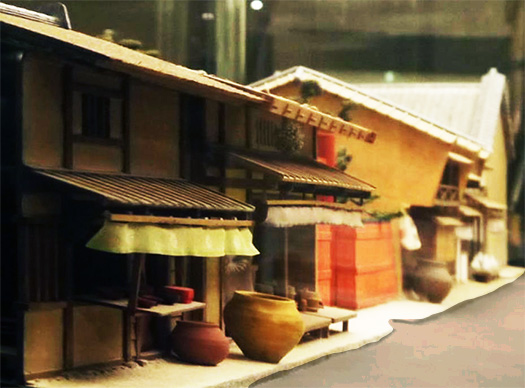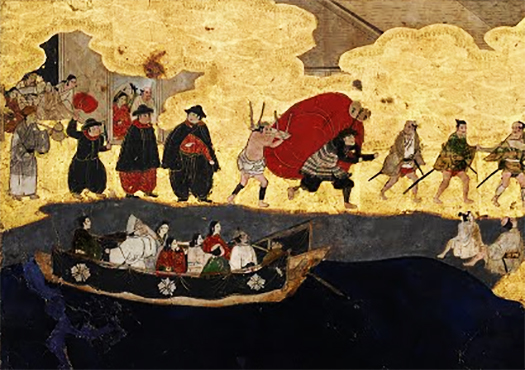


上の写真は堺市博物館の中世都市復元模型街並み。
日本の都市は街道筋に面した商家が両側から客引きするようなのが基本。
この中世都市・堺では住吉大社祭礼ということもあり人出が多い。
集落と集落の間、境界に成立したケースが多いと言われる。
また、いわゆる「街道筋」という交通往来の多い道路両側に商家が陣取った。
建物的には基本は切妻で必然的にその平側が「平入り」の店舗になった。
誘い込む、という深層心理からか、あるいは雨の日の軒下の有用性を意図してか
さしかけの軒の出が特徴になっていく。
また、その軒も徐々に深さが増していって、
雨の当たらない半内部的な空間ができるようになっていく。
雁木空間が商取引の空間に似つかわしく作られていったのでしょう。
そこには平台が置かれて、その店の扱い商品見本などが展示され
いわゆる「見世」として通行者に視覚的に訴求されるようになっていく。
ショーウィンドウディスプレイという知恵と工夫が発展していく。
400年前の住吉大社祭事を描く絵画では
大阪住吉から、堺の中心街まで要所にこういう町家商家が軒を並べている。
街の性格によってそれぞれ特色ができていって、
それこそ「鉄砲町」みたいなそのものズバリの名前まで出現した。
日本列島で最後に大都市化した札幌の街並みを経験してきた年代として
こういった日本的商家、街並み形成へのリアリティを持っている。
いまの時代、このような人間歩行での街並みが全国的に廃れて
クルマでの通行に適合させた郊外型タウンとか、
店舗そのものはあくまでもこの時代以来の歩行者中心だけれど、
立地は郊外の地価の安い大規模ショッピングゾーンなどに
日本人の生活習慣が大きく変化してきている。
子どもの頃の「駄菓子屋」的なものへのノスタルジーが突然表出したりもする。
今後とも、日本の商ビジネスがどうなっていくか、だけれど
こういったマザーのような街並みが基本であることは間違いがない。
下の絵を見ると、堺の街の入口とおぼしき運河沿いに木戸があって、
そこから町家空間が連続しています。環濠都市。
やはり軒が各店から出ていて、それが連続している様子もわかる。
海岸近くということからか、松並木が植え込まれてもいますね。
祭礼行列のなかには、いかにも西洋人の扮装の人物も描かれている。
鎖国は1639年とされるので、それ以前にこの祭礼図は描かれたか。
ルイスフロイスの日本史のなかに住吉まつりの記述があると既報しましたが、
この図画は江戸時代初期のものとされているので、
国際貿易港らしく、鎖国前の時期には異人さんたちが
このように闊歩していたのでしょうね。まるで開国後の神戸のように。
English version⬇
[400 years ago, Sakai Machiya / Cityscape / Japanese Good House Special Edition ㊱-5]
The photo above is the Sakai City Museum’s medieval city restoration model cityscape.
Basically, Japanese cities are attracted by merchants facing the highway from both sides.
In this medieval city, Sakai, there are many people because it is a festival of Sumiyoshi Taisha.
It is said that there are many cases where a boundary is established between villages.
In addition, merchants camp on both sides of the so-called “highway”, which has a lot of traffic.
In terms of the building, it was basically a gable, and inevitably the flat side became a “flat entrance” store.
Is it from the deep psychology of inviting, or is it intended to be useful under the eaves on a rainy day?
The appearance of the eaves is becoming a feature.
Also, the eaves are gradually increasing in depth,
A semi-internal space that is not exposed to rain will be created.
It seems that the ganki space was created to resemble the space for commercial transactions.
A flatbed is placed there, and samples of products handled by the store are displayed.
It is becoming more and more visually appealing to passers-by as a so-called “view”.
The wisdom and ingenuity of show window displays will develop.
In the painting depicting the Sumiyoshi Taisha festival 400 years ago
From Sumiyoshi, Osaka to the center of Sakai, these machiya merchants are lined up at key points.
Each has its own characteristics depending on the character of the city.
That’s what even the name of itself, such as “Teppocho”, has appeared.
As the age when I experienced the cityscape of Sapporo, which became the last big city in the Japanese archipelago
It has the reality of such a Japanese merchant house and cityscape.
In this era, the cityscape of such human walking is obsolete nationwide.
Suburban towns that comply with car traffic,
The store itself has been pedestrian-centered since this era,
The location itself is in a large-scale shopping zone with low land prices in the suburbs
The lifestyle of Japanese people is changing drastically.
The nostalgia for something like a “candy store” when I was a kid suddenly appears.
What will happen to Japanese commerce business in the future?
However, there is no doubt that such a mother-like cityscape is the basis.
Looking at the picture below, there is a Kido along the canal that seems to be the entrance to the city of Sakai.
The townhouse space continues from there. Moat city.
After all, you can see that the eaves are coming out from each store and that they are continuous.
Because it is near the coast, pine trees are planted.
In the festival procession, a person dressed as a Westerner is also depicted.
Since the seclusion is said to be 1639, was this ritual map drawn before that?
I have already reported that there is a description of the Sumiyoshi Festival in the history of Japan by Luis Frois.
This painting is said to be from the early Edo period, so
Still, strangers seemed to be a trading port in the pre-isolation period
I think he was struggling like this. It’s like Kobe after the opening of the country.
Posted on 7月 10th, 2021 by 三木 奎吾
Filed under: 「都市の快適」研究, 住宅マーケティング







コメントを投稿
「※誹謗中傷や、悪意のある書き込み、営利目的などのコメントを防ぐために、投稿された全てのコメントは一時的に保留されますのでご了承ください。」
You must be logged in to post a comment.